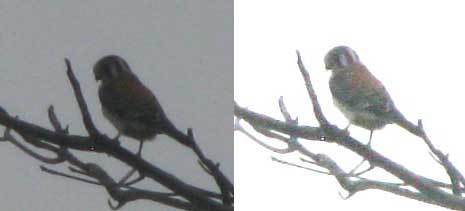Excerpts from Jim Conrad's
Naturalist Newsletter

from the February 25, 2008 Newsletter issued from near Vicente Carranza, in the Central Valley of Mexico's Southernmost State, CHIAPAS
A DAZED KESTREL
Tuesday I walked into my dwelling to find an American Kestrel, FALCO SPARVERIUS, on the floor, as shown above.
I could guess what the story was: One of the men in the community had found the bird half dead in his field and brought him to me. Recalling the dead magpie-jay of a couple of weeks ago, the dead chicken and the dead dog that'd been found that very Tuesday morning, and how also that morning as most mornings men had marched from town wearing spray tanks on their backs, I could also guess what the falcon's problem was. Right now through my back door I see men walking across their fields below waving applicator nozzles back and forth over the ground like magic wands as they spray their chemicals. The men wear bandanas across their noses, but my own nose stings from hundreds of feet away.
After about an hour the falcon clambered atop a bag of corn, then heavily flew onto a wire where he perched with his eyes closed all during a visit of some journalists who came to interview me. A couple of hours later he exited my door on a downward trajectory. I hadn't the spirit to go see if he'd reached someplace decent.
People here seem surprised when I tell them that I grew up calling the little falcons Sparrow Hawks, because they prey on small birds. They're lizard eaters, people here insist, and it's true that when a House Gecko ran up my wall my dazed visitor seemed to perk up, but not enough to go snatch a meal.
American Kestrels are distributed from northern Alaska to Panama. Here they're permanent residents but in the Yucatan and Chiapas's northern Gulf lowlands they're only winter visitors. Howell refers to a "tropicalis group" resident from Oaxaca to central Honduras, which includes our area.
from the October 23, 2011Newsletter issued from Mayan Beach Garden Inn 20 kms north of Mahahual, Quintana Roo, México
BIRDING WITH PHOTOSHOP
In such darkly overcast weather often the views I got of birds this week amounted to no more than black silhouettes against a gray but glaring sky. Still, when a small falcon swooped overhead and landed atop a nearby tree, despite seeing no colors at all it sure looked like an American Kestrel, FALCO SPARVERIUS.
Several falcon species occur here so I needed to confirm that this wasn't something rare. Though through the binoculars all I saw was a black silhouette, I photographed the bird. Once the image was on my laptop screen I went into the PhotoShop image-editing program and very much overexposed the image by grossly increasing both brightness and contrast. Before and after shots can be compared below:

The overexposed picture won't win any photography awards but at least it shows the "whiskers" on the bird's face and a rusty back, and that's enough to confirm the bird's identity as an American Kestrel. Kestrels are present in the Yucatán only during the Northern winter, so this bird also has just arrived.